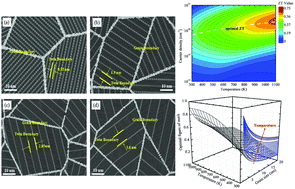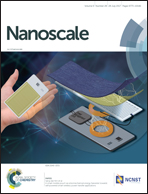Decouple electronic and phononic transport in nanotwinned structures: a new strategy for enhancing the figure-of-merit of thermoelectrics†
Abstract
Thermoelectric (TE) materials manifest themselves to enable direct conversion of temperature differences to electric power and vice versa. Though remarkable advances have been achieved in the past decades for various TE systems, the energy conversion efficiency of TE devices, which is characterized by a dimensionless figure-of-merit (ZT = S2σT/(κel + κph)), generally remains a poor factor that severely limits TE devices’ competitiveness and range of employment. The bottleneck for substantially boosting the ZT coefficient lies in the strong interdependence of the physical parameters involved in electronic (S and σ, and κel) and phononic (κph) transport. Herein, we propose a new strategy of incorporating nanotwinned structures to decouple electronic and phononic transport. Combining the new concept of nanotwinned structures with the previously widely used nanocrystalline approach, the power factor of the nanotwin-nanocrystalline Si heterostructures is enhanced by 120% compared to that of bulk crystalline Si, while the lattice thermal conductivity is reduced to a level well below the amorphous limit, yielding a theoretical limit of 0.52 and 0.9 for ZT coefficient at room temperature and 1100 K, respectively. This value is almost two orders of magnitude larger than that for bulk Si and twice that for polycrystalline Si. Even for the experimentally obtained nanotwin-nanocrystalline heterostructures (e.g. grain size of 5 nm), the ZT coefficient can be as high as 0.26 at room temperature and 0.7 at 1100 K, which is the highest ZT value among all Si-based bulk nanostructures found thus far. Such substantial improvement stems from two aspects: (1) the improvement in the power factor is caused due to an increase in the Seebeck coefficient (degeneracy of the band valley) and the enhancement of electrical conductivity (the reduction of the effective band mass) and (2) the significant reduction of the lattice thermal conductivity is mainly caused due to the extremely strong phonon-grain boundary and phonon-twin boundary scattering. Our results suggest that nanotwinned structures are excellent building blocks for enhancing TE performance in diamond-like semiconductors, and our study provides a new strategy for the innovative development of other TE materials.



 Please wait while we load your content...
Please wait while we load your content...